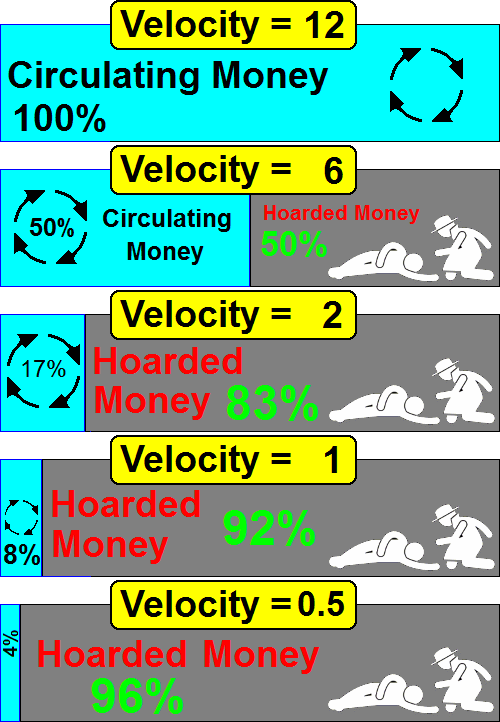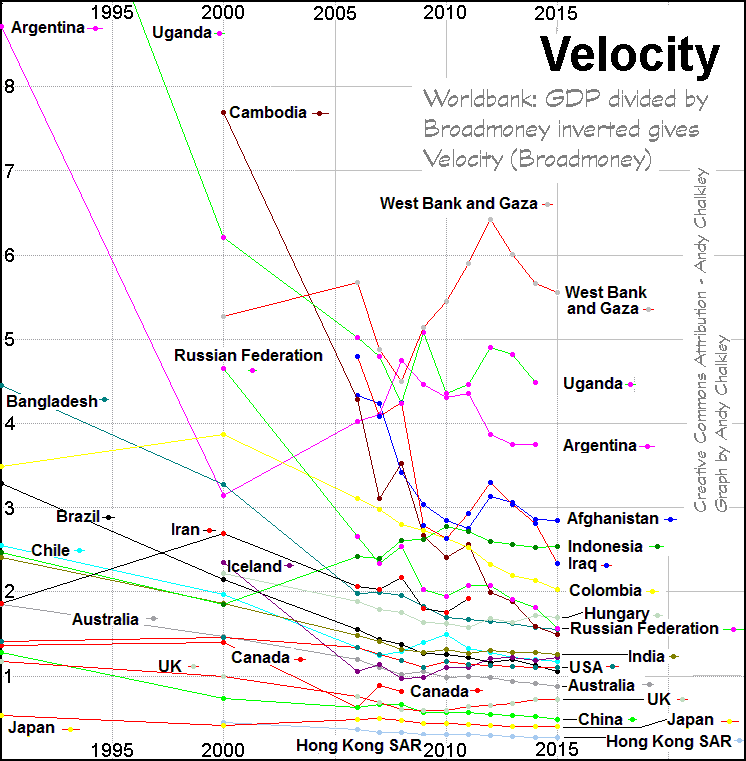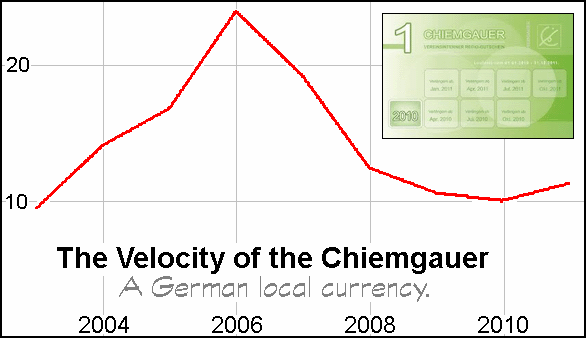Chapter 18 - Low Velocity
Low velocity is characterised by a high level of Hoarded Money. The economy becomes more sensitive to variations in Money Supply. I give you this graph again to revise the relationship between velocity, Circulating Money, and Hoarded Money:
One can see from the next diagram that a one percentage fall in the Money Supply will have a bigger influence on the magnitude of the Circulating Money.
- At a velocity of 12, a 1% fall in the Money Supply will cause a 1% fall in Circulating Money.
- At a velocity of 6, a 1% fall in the Money Supply will cause a 2% fall in Circulating Money.
- At a velocity of 2, a 1% fall in the Money Supply will cause a 6% fall in Circulating Money.
- At a velocity of 1, a 1% fall in the Money Supply will cause a 12% fall in Circulating Money.
- At a velocity of 0.5, a 1% fall in the Money Supply will cause a 24% fall in Circulating Money.
With a low velocity, it becomes exceedingly difficult to maintain a Money Supply and in particular to maintain Circulating Money at a steady figure. A minor change in the rate at which banks lend money will have large effects on economic activity.
At low velocities, the economy is extremely sensitive to minor falls in the Money Supply.
Here are some typical velocity graphs:
At low velocity, the proportion of money that is circulating is very small. I show this in these graphs for Canada:
The next observation concerning an economy with low velocity is that a small change in velocity causes an equal proportionate change in Circulating Money.
- At a velocity of 12, a 10% fall in velocity will cause a 10% fall in Circulating Money.
- At a velocity of 6, a 10% fall in velocity will cause a 10% fall in Circulating Money.
- At a velocity of 2, a 10% fall in velocity will cause a 10% fall in Circulating Money.
- At a velocity of 1, a 10% fall in velocity will cause a 10% fall in Circulating Money.
- At a velocity of 0.5, a 10% fall will in velocity cause a 10% fall in Circulating Money.
A bigger issue in an economy with low velocity is that an increase in Hoarded Money of 1% will cause a greater change in Circulating Money:
- At a velocity of 6, a 1% increase in hoarding will cause a 1% fall in Circulating Money. [1]
- At a velocity of 2, a 1% increase in hoarding will cause a 5% fall in Circulating Money. [1]
- At a velocity of 1, a 1% increase in hoarding will cause an 11% fall in Circulating Money. [1]
- At a velocity of 0.5, a 1% increase in hoarding will cause a 23% fall in Circulating Money. [1]
At low velocity, the economy is extremely sensitive to minor increases in the Hoarded Money component of the Money Supply.
The reverse is also true. With a low velocity, a small reduction in the size of the Hoarded Money section of the Money Supply will give a massive boost to the economy.
- At a velocity of 6, a 1% decrease in hoarding will cause a 1% rise in Circulating Money.
- At a velocity of 2, a 1% decrease in hoarding will cause a 5% rise in Circulating Money.
- At a velocity of 1, a 1% decrease in hoarding will cause an 11% rise in Circulating Money.
- At a velocity of 0.5, a 1% decrease in hoarding will cause a 23% rise in Circulating Money.
At a velocity of 1, a 0.1% instant tax on all Hoarded Money would theoretically cause a rise in the GDP of 1.1%. This is a tax of $1 in $1000. Far less severe than the confiscation percentages mentioned in ‘bail-in’ documents. (GDP and circulating are directly related. [2])









